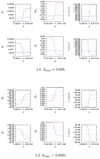The role of feedback in the formation of morphogen territories
- PMID: 18613734
- PMCID: PMC2730544
- DOI: 10.3934/mbe.2008.5.277
The role of feedback in the formation of morphogen territories
Abstract
In this paper, we consider a mathematical model for the formation of spatial morphogen territories of two key morphogens: Wingless (Wg) and Decapentaplegic (DPP), involved in leg development of Drosophila. We define a gene regulatory network (GRN) that utilizes autoactivation and cros-sinhibition (modeled by Hill equations) to establish and maintain stable boundaries of gene expression. By computational analysis we find that in the presence of a general activator, neither autoactivation, nor cross-inhibition alone are sufficient to maintain stable sharp boundaries of morphogen production in the leg disc. The minimal requirements for a self-organizing system are a coupled system of two morphogens in which the autoactivation and cross-inhibition have Hill coefficients strictly greater than one. In addition, the GRN modeled here describes the regenerative responses to genetic manipulations of positional identity in the leg disc.
Figures













References
-
- Brook WJ, Cohen SM. Antagonistic interactions between wingless and decapentaplegic responsible for dorsal-ventral pattern in the drosophila leg. Science. 1996;273(5280):1373–1377. - PubMed
-
- Diaz-Benjumea FJ, Cohen SM. Wingless acts through the shaggy/zeste-white 3 kinase to direct dorsal- ventral axis formation in the drosophila leg. Development. 1994;120(6):1661–1670. - PubMed
-
- Entchev EV, Schwabedissen A, Gonzalex-Gaitan M. Gradient formation of the tgf-beta homolog dpp. Cell. 2000;103:981–991. - PubMed
-
- Gierer A, Meinhardt H. A theory of biological pattern formation. Kybernetik. 1972;12:30–39. - PubMed
-
- H M. Space-dependent cell determination under the control of morphogen gradient. J Theor Biol. 1978;74(2):307–321. - PubMed
Publication types
MeSH terms
Substances
Grants and funding
LinkOut - more resources
Full Text Sources
Molecular Biology Databases
Miscellaneous
